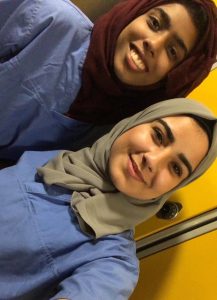Watching Surgery
By Neha Sadik (3rd year medical student)
Attending a surgery has always been a big dream of mine. Since I was about 13 years old I knew I wanted to become a surgeon (it came as a huge disappointment when I found out you had to become a doctor first). Since actually joining medical school, these aspirations of becoming a surgeon have taken a bit of a backseat and a lot of the glitz and glamour of the medical speciality has worn away but attending surgery as a medical student for the first time was still a big deal.
One of the major downsides (for me at least) is how early surgery starts. Unlike most other medical specialities where the starting time is 9 am, surgical specialities aim to begin at 8 am every morning. This means I have to wake up much earlier than I would like to reach the hospital at an appropriate time. Once I reach the hospital, I meet up with my friend and we form a game plan to get a mandatory sign-off in our logbook. These are signatures we need to collect when we scrub up or take a history from a patient for example.
 Once we’ve scrubbed up and achieved a signature, we ask a friendly junior doctor if he is happy to have us in a gastrointestinal elective surgery. Usually the senior consultant surgeon only comes in once the more junior surgeons have prepped the patient and the patient is already anaesthetised. Thankfully, the junior doctor lets us in and explains what’s going on. In an operating theatre, the members of the multi-disciplinary team have usually been working together for a long time and all know their specific jobs, working like parts of a machine to complete the surgery in a skilled and efficient manner.
Once we’ve scrubbed up and achieved a signature, we ask a friendly junior doctor if he is happy to have us in a gastrointestinal elective surgery. Usually the senior consultant surgeon only comes in once the more junior surgeons have prepped the patient and the patient is already anaesthetised. Thankfully, the junior doctor lets us in and explains what’s going on. In an operating theatre, the members of the multi-disciplinary team have usually been working together for a long time and all know their specific jobs, working like parts of a machine to complete the surgery in a skilled and efficient manner.
One of the most important things, I soon realise, is not to get in the way of anyone. This proves difficult when there are 3 surgeons surrounding the patient’s body and you want a good view of the action! After a bit of shuffling around we manage to find a spot near the anaesthetists where we can see the surgeon’s handiwork and get lightly quizzed on the anatomy of the intestines. Even though it’s hard to stay completely focussed for 2 hours when you’re not directly involved in everything that’s going on, the surgical questions helped me to stay interested.
 Thankfully, when we reach the end of the surgery, it all pays off. The consultant removes a massive volvulus from the patient’s abdomen and the scrub nurse places it into a bucket. A volvulus occurs when a loop of intestine twists around on itself and causes obstruction of the bowels which can be a serious issue. This volvulus is one of the biggest that all the surgeons have ever seen and many members of the team go to admire it in all its glory. Even though surgery has its drawbacks, no one can deny that surgery is endlessly exciting. My friend and I leave the theatre as the patient is being stitched up and discuss how incredible surgery is as we get ready to leave.
Thankfully, when we reach the end of the surgery, it all pays off. The consultant removes a massive volvulus from the patient’s abdomen and the scrub nurse places it into a bucket. A volvulus occurs when a loop of intestine twists around on itself and causes obstruction of the bowels which can be a serious issue. This volvulus is one of the biggest that all the surgeons have ever seen and many members of the team go to admire it in all its glory. Even though surgery has its drawbacks, no one can deny that surgery is endlessly exciting. My friend and I leave the theatre as the patient is being stitched up and discuss how incredible surgery is as we get ready to leave.
This surgical experience made me revisit my previous ambitions and see surgery in a whole new light- it is the perfect combination of artistry and science to provide life-changing benefits to the patient. Maybe surgery is for me after all…
